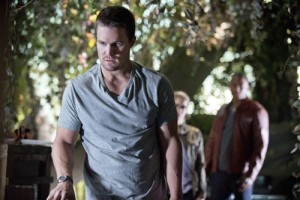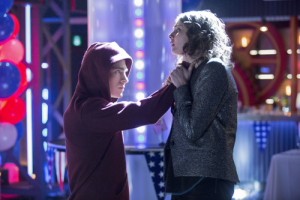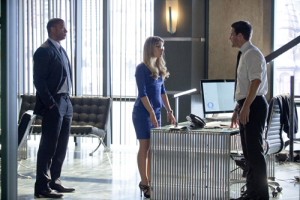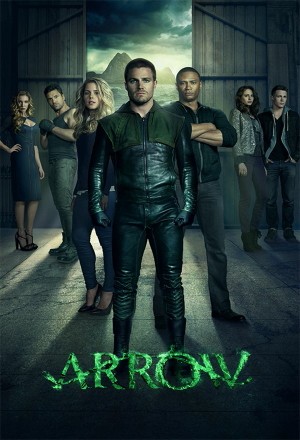Arrow is entering its third season this fall, and it’d be accurate to say that it’s highly anticipated. This is also the case for the Flash series airing in the fall, on the CW as well. Not to mention the shows not connecting to the Arrow universe with similar premises on the other networks. NBC’s Constantine is starting around the same time, and also Fox’s long gestating Gotham series. It’s pretty likely that these shows are finding new life thanks in no small part to the amount of success the CW’s Arrow has enjoyed up to this point, and could possibly achieve in its third season as well.
 Regardless, After a successful freshman showing, it was unclear which direction they planned to go in. Obviously Oliver’s storyline was disrupted due to his failure to save the Glades in the incredibly bold season one finale, so it was uncertain where we’d find him as season two began. From the opening shot of City of Heroes (the first episode of season two), it was apparent that they wanted to go even bigger than the epic level that season one eventually reached. And by the end of the episode, we could see that Oliver’s journey had only just begun. It was also shocking to learn that a whole year had passed since Tommy’s death. So even more interesting than the paths that the other characters had gone down in the wake of the Undertaking was how much effort went in to revealing the way the city had changed after not only the Glade’s destruction, but after Oliver’s absence. This was clearly not the same Starling City Oliver had returned to in the beginning of season one. City of Heroes changed the sprawling urban landscape of season one in to one of urban decay (post quake) that really set the stage, and in doing so was one of the most important and successful episodes at conveying the direction the season was taking.
Regardless, After a successful freshman showing, it was unclear which direction they planned to go in. Obviously Oliver’s storyline was disrupted due to his failure to save the Glades in the incredibly bold season one finale, so it was uncertain where we’d find him as season two began. From the opening shot of City of Heroes (the first episode of season two), it was apparent that they wanted to go even bigger than the epic level that season one eventually reached. And by the end of the episode, we could see that Oliver’s journey had only just begun. It was also shocking to learn that a whole year had passed since Tommy’s death. So even more interesting than the paths that the other characters had gone down in the wake of the Undertaking was how much effort went in to revealing the way the city had changed after not only the Glade’s destruction, but after Oliver’s absence. This was clearly not the same Starling City Oliver had returned to in the beginning of season one. City of Heroes changed the sprawling urban landscape of season one in to one of urban decay (post quake) that really set the stage, and in doing so was one of the most important and successful episodes at conveying the direction the season was taking.
After pushing off in to the season with such a strong premiere, season two refused to let up as the Arrow universe continued to expand by introducing new characters and situations with a deeper focus on finding an even line between the comic book and live-action. Many were skeptical when the producers hinted at possibly introducing the concept of the superhero in to the Arrowverse, which had previously been established as a no nonsense sort of parallel reality where the feats and events were spectacular yet grounded. We were exposed to a little bit of this in the sci-fi fueled episode The Undertaking (The season one finale) where they introduced to existence of the Earthquake Machine. But they took a step further when they showcased the idea of a superdrug in to the series. Mirakuru opened the door to the impossible; and the Cyrus Gold fights fortunately came across just as effectively as the conflicts between the street level competitors, despite toeing the line between realism and cheese. It showed that Arrow was fully capable of keeping the grounded atmosphere while maintaining a comic book level of possibility. No part of the series showcased this level of possibility in a more exciting way than the Flash’s origin!

We knew that there was supposed to be more prominent sci-fi elements once the second season started, but to actually see Barry Allen get his powers was a pleasant surprise that no one could have been fully prepared for. What was even more surprising is how little the origin was altered from its comic book predecessor. It really conveyed the level of dedication that the creative team has had in giving the right amount of attention to the source material while they tell their own story.
It was also incredibly rewarding to see how far Oliver had come by training with Slade in the flashbacks; which blended seamlessly with the modern scenes in almost every episode. They also gave a real sense of the time difference thanks to the two versio ns of the character played with a successful level of subtlety from Stephen Amell’s knack for both emotional and physical acting. These scenes commanded a tremendous amount of attention as we not only got to see the evolution of Oliver as a fighter, but also the events that led to the creation of his other personality, the Hood. All of this is punctuated finely by Manu Bennett’s desperate and brutal progression from Slade Wilson to Deathstroke. His entire character arc was such a small part of the series, but because of his commanding magnetism he used his imposing presence to come across as a truly threatening antagonist to Oliver. His character was so complex and incredibly well realized that he blew villains like Malcolm Merlyn, Isabel Rochev, and Sebastian Blood away in just sheer intimidation. It elevated the character of Slade to a level, if not on, appropriately near his comic book counterpart.
ns of the character played with a successful level of subtlety from Stephen Amell’s knack for both emotional and physical acting. These scenes commanded a tremendous amount of attention as we not only got to see the evolution of Oliver as a fighter, but also the events that led to the creation of his other personality, the Hood. All of this is punctuated finely by Manu Bennett’s desperate and brutal progression from Slade Wilson to Deathstroke. His entire character arc was such a small part of the series, but because of his commanding magnetism he used his imposing presence to come across as a truly threatening antagonist to Oliver. His character was so complex and incredibly well realized that he blew villains like Malcolm Merlyn, Isabel Rochev, and Sebastian Blood away in just sheer intimidation. It elevated the character of Slade to a level, if not on, appropriately near his comic book counterpart.
Of course the highlights of the season came from not just the unlimited level of possibility thanks to the introduction of superpowers in to the show, but also the strong performances from the supporting cast, and commitment to fully realizing their stories. Roy and Thea’s story remains stron g at the beginning of series, but Roy starts to pull ahead when his arc becomes much more involved and eventually leaves Thea’s far behind. It’s always risky to connect two characters too strongly. They can either both go nowhere or one can leave the other in the dust. This is why most duos in any show or story have to split up. As a result, Thea’s character found herself in a sort of limbo towards the end of the show that could have been avoided. Willa Holland’s charm wasn’t utilized effectively, and the character became stagnant as a result. However from her final scene in Unthinkable(The season two finale), it’s clear that she’ll have a much more involved arc in season three to make up for it. Not to say that it’s Roy’s turn to languish. On the contrary, his character’s arc in season two had a lot of strong moments that focused on his evolution as a hero, and his struggle with anger, which Colton Haynes absolutely nails.
g at the beginning of series, but Roy starts to pull ahead when his arc becomes much more involved and eventually leaves Thea’s far behind. It’s always risky to connect two characters too strongly. They can either both go nowhere or one can leave the other in the dust. This is why most duos in any show or story have to split up. As a result, Thea’s character found herself in a sort of limbo towards the end of the show that could have been avoided. Willa Holland’s charm wasn’t utilized effectively, and the character became stagnant as a result. However from her final scene in Unthinkable(The season two finale), it’s clear that she’ll have a much more involved arc in season three to make up for it. Not to say that it’s Roy’s turn to languish. On the contrary, his character’s arc in season two had a lot of strong moments that focused on his evolution as a hero, and his struggle with anger, which Colton Haynes absolutely nails.
Diggle and Felicity’s stories run parallel with Oliver’s, but never end up feeling dependent. From the beginning o f the series, it’s been clear that Oliver can’t succeed in his crusade alone. But the pleasant surprise comes from the help that he gets in Dig and Felicity; who have such a strong connection with him not only as comrades but as unexpected friends. They end up filling out the parts of Oliver’s personality that are missing, but they never feel like just a supplement. They forward their own stories and agendas, but their bond keeps their team together not just mechanically, but in the eyes of their viewers, making this the most strongly perceived aspect of the season, and possibly the entire series. Whatever is in store for the show now, the main thing that season two’s success hinged on was the utilization of this relationship. Luckily, the writers knew exactly how to play to its strengths, and introduced the perfect amount of conflict and camaraderie to keep the characters in just the right light.
f the series, it’s been clear that Oliver can’t succeed in his crusade alone. But the pleasant surprise comes from the help that he gets in Dig and Felicity; who have such a strong connection with him not only as comrades but as unexpected friends. They end up filling out the parts of Oliver’s personality that are missing, but they never feel like just a supplement. They forward their own stories and agendas, but their bond keeps their team together not just mechanically, but in the eyes of their viewers, making this the most strongly perceived aspect of the season, and possibly the entire series. Whatever is in store for the show now, the main thing that season two’s success hinged on was the utilization of this relationship. Luckily, the writers knew exactly how to play to its strengths, and introduced the perfect amount of conflict and camaraderie to keep the characters in just the right light.
Season two gave a glimpse in to the possibilities of the larger Arrow universe. But more than that, it cemented Oliver’s status as a hero. Even so, his part was just a fraction of a broader story involving all of the characters. It’s not necessarily known by the less comic book savvy members of the audience that most of these characters have their roots in the source material. Season two put them all on a road with incredible similarities to their comic book counterparts. I’m sure that even though the series (and this review) has parts of it that are specifically targeting those long time fans, but for the rest of the audience it’s just a welcome surprise to start to see these characters come in to their own. The season was especially successful at broadening the universe, and giving us our first glimpse at the heroes and villains that are on their way to becom ing the future staples of the series. There were minor problems that stayed consistent with the season; with villains that just didn’t stick and ended up becoming throwaways, a rough and uncertain progression for the character of Laurel, and anticlimactic and unfitting ends for the major villain characters of Isabel and Blood. Most of this is just plain nitpicking, but on the whole Season two surpassed the first season in virtually every way by finding a substantial villain in Deathstroke, plenty of supporting characters to fill the world with multiple perspectives, and a finale that sets a new chapter in motion seamlessly. With a great showing though comes a higher bar, and I’d say it’d be unlikely for Arrow to be able to top this level of excellence. Or at least I would, if they hadn’t already shown they could once before. And I for one am looking forward to seeing them do it yet again.
ing the future staples of the series. There were minor problems that stayed consistent with the season; with villains that just didn’t stick and ended up becoming throwaways, a rough and uncertain progression for the character of Laurel, and anticlimactic and unfitting ends for the major villain characters of Isabel and Blood. Most of this is just plain nitpicking, but on the whole Season two surpassed the first season in virtually every way by finding a substantial villain in Deathstroke, plenty of supporting characters to fill the world with multiple perspectives, and a finale that sets a new chapter in motion seamlessly. With a great showing though comes a higher bar, and I’d say it’d be unlikely for Arrow to be able to top this level of excellence. Or at least I would, if they hadn’t already shown they could once before. And I for one am looking forward to seeing them do it yet again.
-PS
Arrow will be back this Fall only on the CW©
All images courtesy of The CW©
Arrow — The CW — © 2014 The CW Network, LLC. All Rights Reserved
http://www.cwtv.com/shows/arrow


I don’t agree. Look at:
https://www.nytimes.com/2015/02/19/arts/television/vikings-and-its-discontent-warlord-begins-its-third-season.html